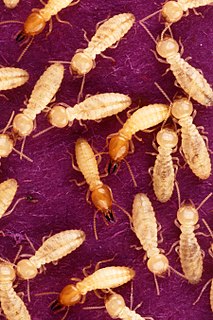
The Formosan termite is a species of termite that has been transported worldwide from its native range in southern China to Taiwan, Japan, South Africa, Sri Lanka, Hawaii, and the continental United States.

Rhinotermitidae is a family of termites (Isoptera). They feed on wood and can cause extensive damage to buildings or other wooden structures. About 345 species are recognized, among these are severe pests such as Coptotermes formosanus, Coptotermes gestroi, and Reticulitermes flavipes.
Coptotermes gestroi, the Asian subterranean termite is a small species of termite that lives underground. Both this species and the Formosan subterranean termite, are destructive pests native to Asia, but have spread to other parts of the world including the United States. In Asia, this species is known as the Philippine milk termite.

Coptotermes is a genus of termites in the family Rhinotermitidae. There are about seventy-one species, many of which are economically destructive pests. The genus is thought to have originated in southeastern Asia. Worker termites from this genus forage underground and move about in roofed tunnels that they build along the surface.
Coptotermes frenchi, the Australian subterranean termite, is a species of termite in the family Rhinotermitidae. Termites are social insects and C. frenchi usually builds its communal nest in the root crown of a tree. From this, a network of galleries extends through the nearby soil, enabling the workers to forage in the surrounding area without emerging on the surface of the ground.

Coptotermes lacteus, the milk termite, is a species of termite in the family Rhinotermitidae, native to Australia. These termites are social insects and build a communal nest in the form of a mound. From this, a network of galleries extends through the nearby soil, enabling the workers to forage in the surrounding area without emerging on the surface of the ground.

Coptotermes acinaciformis is a species of subterranean termite in the family Rhinotermitidae native to Australia. Termites are social insects and build a communal nest. In the case of C. acinaciformis, this is either in the root crown of a tree or underground. From this, a network of galleries extends through the nearby soil, enabling the workers to forage in the surrounding area without emerging on the surface of the ground. This termite can cause substantial damage to trees and the wooden parts of buildings.
Coptotermes elisae, the Papuan plantation termite, is a species of termite in the family Rhinotermitidae. It is native to New Guinea, Indonesia, and Southeast Asia, where it attacks and kills living trees and damages structural timbers.
Pilibacter is a genus of bacteria of the Enterococcaceae. This genus contains a single species, Pilibacter termitis, strains of which were isolated from a termite.
Neotermes greeni, is a species of drywood termite of the genus Neotermes. It is native to India and Sri Lanka. It closely resembles Postelectrotermes militaris. It is a minor pest of tea in Sri Lanka, and major pest of mango in India.
The Indo-Malaysian drywood termite,, is a species of dry wood termite of the genus Cryptotermes. It is found in Philippines, Australia, Papua New Guinea, Hawaii, and introduced to Sri Lanka. It is the smallest termite species in Australia, with 2.5 – 3.7mm in soldiers.
Coptotermes emersoni, is a species of subterranean termite of the genus Coptotermes. It is native to India, Sri Lanka, and Vietnam. Though it is a wood destroying termite, it was first found from an electrical wire case in the National Museum of Colombo.
Coptotermes gaurii, is a species of subterranean termite of the genus Coptotermes. It is native to South India and Sri Lanka. It is a serious pest of tea in Sri Lanka.
Heterotermes indicola, is a species of subterranean termite of the genus Heterotermes. It is native to tropical India, Pakistan and Sri Lanka but has extended its range into the subtropics and warm temperate areas of the Himalayan foothills to altitudes of about 2,000 m (6,600 ft). It causes damage to timber in buildings and is one of the most destructive termites in urban and agricultural areas in the world. Soldiers are about 4.05-4.89mm long. Extracts of garlic and Calotropis procera are known to have Termiticidal effects on H. indicola.

Odontotermes horni, is a species of termite of the genus Odontotermes. It is native to India and Sri Lanka. It attacks many dead, decaying trees and fertilized soil. Though nests on ground, they do not construct a termitaria. It is a pest of tea, coconut and sugarcane.
The Snouted harvester termite,, is a species of mound building termite of the genus Trinervitermes. It is native to India and Sri Lanka. Type species was described from Bandarawela area of Sri Lanka. It is a pest of sugarcane, and brinjal.
Coptotermes heimi is a species of termite in the family Rhinotermitidae. It is found in India, Pakistan and Bangladesh and lives wholly underground.
Acanthaspis quinquespinosa is a species of assassin bug found in India, Sri Lanka, Myanmar, Nepal and Tibet. It is a predator, and both nymphs and adults feed on termites, beetles, caterpillars and other insect prey.






